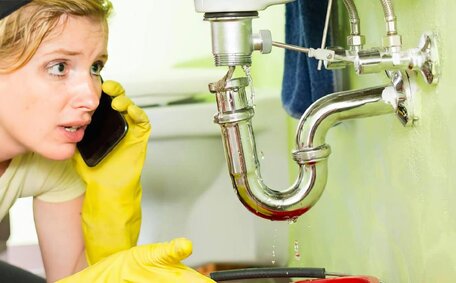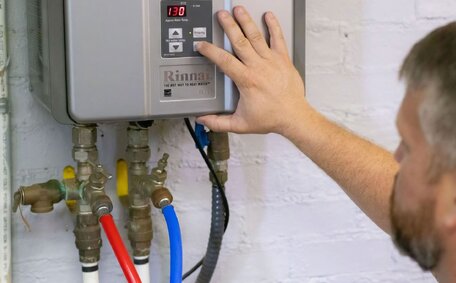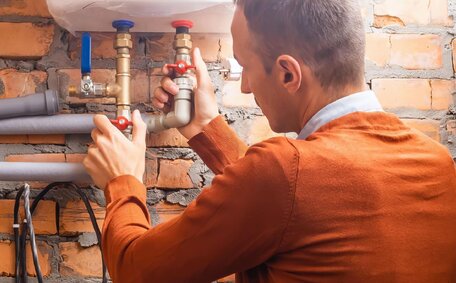When Should You Consider Relining Vertical Pipes?
Vertical stack pipe relining should be considered when high-rise buildings start exhibiting signs of damaged pipes in the draining systems. This may include frequent clogs, leaks, water damage around vertical stacks, slowing water flow in your new pipes, gurgling sounds, or cracked drainage pipes. As buildings age over time, typically 30-50 years, cast iron pipes often corrode, crack, or become obstructed with built-up sediment, fortunately, our skilled team is able to reline vertically stacked drains with no dig technology.
Relining can revitalise your pipes, eliminating the need to dig up areas, offering a minimally invasive technique to mend existing sewer pipes within tenant spaces or risers without demolishing walls or floors. The process involves maneuvering a liner coated with epoxy resin into pipe interiors, avoiding the no need to excavate floors or walls, to form a smooth, seamless 'pipe within a pipe’ that is corrosion resistant and watertight.
Compared to extensive pipe replacement, which would need excavate substantial areas and disrupt normal routines, pipe lining emerges as a cost-effective and non-intrusive solution your budget will appreciate. It also lessens tenant disruption and prevents damage, which is where our premium pipe relining services make a significant difference. The outcome of the pipe relining how process is revitalised internal plumbing without compromising capacity for fluid movement and life expectancy exceeding 50 years, often achievable within the same day of service.
Rest assured, our valued customers in high rise buildings experiencing persistent drainage issues inside vertical pipe stacks, trenchless pipe relining is an efficient, contemporary solution. Engage with us for an expert evaluation to determine if your property could benefit from a relining solution tailored to your high-rise’s specific needs.
Identifying If A Vertical Pipe Can Be Relined
Determining the condition of your plumbing begins with a thorough CCTV survey of the damaged pipe. A plumber will deftly navigate a CCTV drain camera on a flexible cable down the entire length of pipe in your drain system, ensuring not to damage your plumbing, to thoroughly assess the pipe’s vital statistics.
Key factors the plumber evaluates in case of broken pipes are:
- Extent of corrosion, cracks, breaks or tree roots intrusions causing obstructions
- If the pipe still maintains its general structure to support a liner
- Existence of joints or access points to feed the lining equipment
- Whether the pipe has reduced capacity due to build-up
Harnessing the footage, our specialists can help by tailoring their approach to suit your specific vertical sewer stormwater pipe needs, ensuring there are no hindrances to a sturdy epoxy relining. All types of pipes can be relined, including cast iron, PVC, concrete, and some clay pipes, revitalising your plumbing system even when it seemed beyond repair.
For professional insights, confer with us about your unique drainage system issues and learn how pipe relining can offer a long-lasting resolution.
Techniques For Relining Vertical Pipes
Make sure you’re familiar with the two common techniques used for relining vertical pipes: Cured-in-Place Pipe (CIPP) lining and Pull-in-Place (PIP) lining.
CIPP lining, which achieves pipe relining benefits, involves resin-saturated felt, proficiently deployed to fortify your sewer line, repairing pipes without need for excavation, using high pressure.
It is promptly inflated and cured with hot water or steam, assuring there’s no need for extraneous work while forging a snug, seamless liner, conferring a permanent solution that your plumbing deserves, executed with meticulous precision. As CIPP lining tubes offer pliability, a vital aspect of the versatile pipe relining solutions, allowing them to traverse bends and acclimatise to an array of pipe configurations.
PIP lining is designed so you don’t need to excavate, using a somewhat rigid epoxy-coated liner tube that integrates within the pipe mechanically. It is primarily suited for straight vertical stacks that lack many joints or bends, effectively setting in place as a new pipe in the repair process. Once in place, the liner expands through heat application, bonding to form a robust new pipe inner wall.
Both CIPP and PIP techniques, at the forefront of relining pipes technology, are exemplary for reviving vertical pipes in high-rises or multi-level constructions. They don’t disturb building structures and require minimal access points through existing drains. This method can also endow your sewer line with waterproof, chemical-resistant characteristics, bolstering flow capacity for the building’s lifespan.
Accessing Vertical Pipes For Relining
To access vertical pipes for relining, liners can installed seamlessly using existing entry points within the pipe system. This commonly involves removing fixtures such as toilets or access panels on lower floors to feed equipment into the plumbing system, as part of the initial steps to repair pipes from the basement or ground level.
To ensure we provide a stellar service, small 5-10cm openings may be strategically core drilled to access underground pipes when existing drains lack alignment with vertical runs needing repair. These strategically positioned access points, employed in our repair methods, ensure all surface damage remains negligible while thermal imaging is used to circumvent wires. Each access point is meticulously restored, ensuring there was seamless integration with the surrounding finishes.
From the entry point, a robotic cutter will come out to eliminate heavy build-up and obstructions within the pipe, setting the stage for an effective drain repair lining deployment. Technicians skilfully utilise water jet regulator testing and airbags to isolate the damaged drain segment, making way for a comprehensive pipe repair that rejuvenates your plumbing within the old framework.
The pipe relining process, whether employing flexible CIPP liners or slightly more rigid PIP tubes, is meticulously carried out inside existing pipelines under controlled conditions. All apparatus is deftly removed once the relining process successfully bonds and restores the pipe integrity, leaving no trace of intervention.
Specialized Equipment Used For Vertical Relining
Pipe relining experts are essential when the task is to intricately recondition vertical sewer lines within the labyrinth of a multi-story building’s intricate drainage systems. Key equipment our technicians use includes:
- Flexible CCTV inspection cameras for initial blocked drains and pipe evaluation
- Pipe cleaning nozzles and robotic cutters to clear blockages
- Inflatable pipe plugs and pressure regulators to isolate pipe sections
- Inversion pipe drums, which are pivotal in adeptly inserting and deploying CIPP liners
- Winch systems to pull in place rigid PIP liners
- Hot steam generators and curing equipment for liner bonding
- Core drilling tools for strategically accessing vertical risers
Our compact and portable machinery proves indispensable and helps us address all your pipe relining needs in confined spaces within service shafts or risers efficiently. We also employ advanced thermal imaging cameras to accurately determine entry points, ensuring precision in our relining jobs while minimising damage to your home.
The specialised camera and relining equipment allows our team to assess, measure then restore your vertical piping infrastructure without invasive demolition. This relining technology enables non-disruptive drain pipe relining repairs to keep your high-rise or commercial building safely operational, exemplifying our commitment to effective pipeline solutions.
Advantages of Relining Over Replacing Vertical Pipes
Cost Savings
Pipe relining presents as a prudent option, markedly cheaper than embarking on a full drainage system replacement. The beauty of this technique is in its simplicity – you do need not upheave landscapes or engage in extensive demolition, pipe installations, and structural modifications are entirely sidestepped.
On average, relining a vertical length of pipe costs $80-250 per linear foot, whereas full replacement fluctuates between $200-500 per linear foot. Short 50 ft sections in high-rises can therefore be relined for under $15,000, a huge saving.
Minimal Disruption to Property
Being a no dig trenchless pipe technology, pipe relining causes minimal impact to facilities or tenant spaces. Walls, floors and indoor aesthetics remain preserved which prevents future disruption as no dig pipe access from the outside is required.
Structural elements stay intact and sewer pipe asset value is maintained. The process generates very little waste while avoiding prolonged downtime, detrimental impacts to business operations are also minimised during repair.
Extended Pipe Lifespan and Functionality
Epoxy and resin-based piping liners, stronger than ever, surpass traditional materials and demonstrate extraordinary robustness, with heightened strength, persistent longevity, and formidable chemical resistance. Lined pipes often outlast traditional piping without having to compromise on durability, with over 50+ years durability.
Smooth sealed inner surfaces within the host pipe manifest the efficacy that pipe relining delivers, presenting enhanced water flow and increased resilience against blockages and leakages. Ongoing maintenance costs are reduced, pondering how long does this pipe’s improved function last.
Environmental Impact
Pipe relining reduces landfill waste by over 90% compared to removing and replacing old pipes. Liner materials are also inert polymers with zero contaminant risks.
With very little material transportation or construction equipment needed onsite, the light carbon footprint vastly lessens environmental damage – critical for eco-conscious corporations.
Considerations For Maintaining Relined Vertical Pipes
Your message on the preservation of longevity of relined vertical pipes suggests that building owners should implement some key maintenance measures and usage guidelines:
Regular Inspections
Even though relined pipes are highly durable, it is advisable to arrange periodic CCTV inspections every 5 years. Technicians can check lining integrity, note any new issues early, and clear minor build-up before it worsens.
Preventing Blockages
Ensuring proper usage guidelines are followed will minimise potential issues with your water pipe after relining:
- Avoid pouring fats/oils down sinks which solidify, hence repairing damaged internal pipework
- Only flush toilet paper and human waste, no wipes or sanitary items
- Use strainers in sink drains to catch food scraps / debris
Professional Maintenance
Supplementary to in-house efforts, should you need them, an annual maintenance service by adept technicians will optimise the condition and performance of your drain pipes. Technicians can perform thorough evaluations, eradicate obstructions, and apply highpressure water jetting to ensure your water maintains its unimpeded flow.
Following these best practises protects the investment in restored vertical pipes, prevents blockages from escalating into costly damages, and extends performance for decades past traditional lifespans.
Choosing The Right Contractor For Your Vertical Relining Project
When selecting a professional plumbing contractor for vertical pipe relining, it’s important to verify their expertise and capabilities. Seek companies who specialise in epoxy pipe relining with extensive experience working in multi-story buildings.
Ensure the business comes with hearty recommendations for your peace of mind that they are licenced, insured and operating above board in your locale. They should have knowledgeable technicians trained in confined space access and certified to safely handle industrial relining equipment.
The reliable relining team will initiate the process by thoroughly assessing your drainage issues. They’ll use CCTV cameras for exact measurements then advise the best plan, pipe materials and relining methods suited to your property.
Transparent quotes outlining scope of works should be provided upfront, including any building access requirements. Timeframes, provisions for minimising tenant disruption, and cleanup responsibilities should also be clarified.
Look for ratings and reviews that convey a very professional service. We are highly recommended for your vertical pipe relining needs, as our quality work and customer service inspire confidence for a successful, long-term result.
For trusted expertise in commercial and residential vertical pipe relining, give us the opportunity to promptly take your call, available 7 days a week, offering peace of mind with our specialist relining services and expert advice. With 20+ years of plumbing and drain restoration experience, we would like to warmly invite you to get in touch via inquiry to discuss your building’s particular needs.






